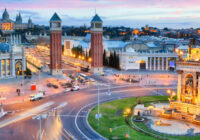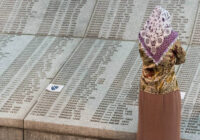The political awakening of Russia’s youth does not bode well for the entrenched regime.
On March 26, protesters hit the streets across Russia over corruption allegations against Prime Minister and former President Dmitri Medvedev. As Russian courts prepare to prosecute those detained during Sunday’s unsanctioned protests, as well as the employees of Alexei Navalny’s Anti-Corruption Foundation (FBK), it is important to identify what sets Russia’s latest series of protests apart from those of the recent past and how it may affect the country’s political landscape as the 2018 presidential election nears.
What is immediately striking is the cause of the protests: “He Is Not Dimon to You,” an investigation into Medvedev’s wealth published on YouTube by anti-corruption activist and one-time Moscow mayoral candidate Navalny on March 2. The video, which has been viewed more than 14 million times, implicates Medvedev (Dimon is a nickname for Dmitry)—a close ally of President Vladimir Putin who briefly replaced him as president from 2008 to 2012 in what was widely considered an act of political theater—in owning secret assets, including mansions, yachts and a vineyard.
Viewed out of context, Navalny’s latest investigation is unremarkable. Medvedev is not the first Russian official to have ill-gotten gains exposed by Navalny, whose brother, Oleg, is currently serving a three-and-a-half-year sentence meant as an (apparently ineffective) leverage over Alexei. Navalny’s greatest hits include investigations targeting Yuri Chaika, Russia’s prosecutor general, and Igor Shuvalov, the first deputy prime minister.
Despite the egregiousness of their alleged corruption—Shuvalov was found to have used a private jet to regularly fly his family’s pet corgis around the world—both men remain in their posts.
Widespread Contempt
The outbreak of protests, which Navalny began organizing on March 15, owes to a specific condition that was absent in the cases of Chaika and Shuvalov: widespread contempt toward Navalny’s target. Medvedev increasingly appears to have given up on pretending he represents the interests of Russians. The country’s middle class made its disapproval of him known when it led the protests of 2011-13, aggrieved at the sight of a self-professed modernizer handing over the reins of power to Putin—a reactionary force that few middle-class Russians wished to see back in office having come to believe that Russia had abandoned its historical tradition of leaders never stepping down.
The working class has joined the chorus of Medvedev’s critics thanks to a string of gaffes highlighting the prime minister’s indifference to Russians’ economic difficulties. In August 2016, Medvedev told Russian teachers distraught over meager pay that their predicament was no one’s fault but their own: “You didn’t go into business, as I understand, so there you have it.”
Worse still, in May 2016, while visiting Crimea, the annexation of which has come at a hefty cost for Russia and its people, Medvedev told worried pensioners, an especially vulnerable segment of the population, “There’s just no money right now. … You hang in there. Best wishes! Cheers! Take care!”
Medvedev, once commonly cited as a potential successor to Putin, made these recommendations as he literally escaped the people in whose name Russia had invaded Ukraine. He neatly symbolizes Russia’s outrageous economic inequality in his clear indifference to the economic problems of ordinary Russians and to the optics of Navalny’s allegations, which he has responded to by blocking Navalny on Instagram and going skiing during Sunday’s protests.
Medvedev’s complacency may stem from the appearance that his place in power is guaranteed. However, recent weeks give reason for doubt about Medvedev’s job security. His behavior has combined with increasing negative attention over Navalny’s accusations to drive even the so-called “loyal” opposition in Russia’s parliament to demand an official investigation into Medvedev’s alleged wealth.
More embarrassingly, Putin appears to be subtly marginalizing the prime minister. At a meeting of Russian officials on March 14, Putin offered a mocking explanation for Medvedev’s absence that almost certainly undercut the prime minister’s authority: “The [flu] epidemic here is waning. Nonetheless, the situation is still serious. See, we weren’t able to save Dmitri Anatolievich.” In a counterproductive move that made him look even more side-lined, Medvedev refuted Putin’s comments on March 23, saying he had never fallen ill.
Russian analysts say Medvedev is under pressure from both elites and the public, and are increasingly considering the possibility that he will be forced to resign.
Pursuit of Political Power
Like Medvedev, Navalny is at a critical juncture in his pursuit of political power. Having been rendered ineligible for the office of president by a recent ruling on the Kirovles case, which has plagued him since 2010, Navalny needs all the public attention he can get in order to remain relevant in Russia’s brutally cynical political landscape. Navalny has vowed to continue his presidential campaign, begun in December, despite the legal obstacle disqualifying his inclusion on the ballot and a media blackout that has limited his efforts to social media, the grassroots and opposition-friendly news outlets.
Medvedev’s situation has given Navalny an opportunity to keep the spotlight on himself, even at the cost of prosecution, and to unite an otherwise divided opposition movement around the universally resonant cause of anti-corruption.
Sunday’s protests appear to have accomplished just that, with Navalny once again under arrest, his organization’s activities indefinitely suspended and an estimated 60,000 people said to have taken part in the countrywide demonstrations, according to reputable independent radio station Ekho Moskvy.
That Navalny managed to organize protests from Kaliningrad to Vladivostok is highly impressive. The FBK announced that 99 locations around the country hosted demonstrations, even Dagestan’s Makhachkala province, where 92% of voters supported Putin in the 2012 election.
By contrast, intermittent protests by truckers over a highway tax enriching the brothers Rotenberg—close friends of Putin at the receiving end of numerous government contracts—have remained largely contained within Russia’s western parts. Similarly, the 2011-13 protests took place mostly in Moscow.
New Wave
Commentators have heavily emphasized the role of youth in Sunday’s protests. Indeed, schoolchildren and university students came out in great numbers across the country, giving rise to a consensus that “the ranks of protesters in Moscow [since the demonstrations of 2011-13] have grown younger,” as articulated by Kommersant. “This group missed the Bolotnaya [Square protests] because of its age,” Novaya Gazeta observed.
This specific group’s media consumption habits make it immune to the state propaganda that dominates Russian television, the same medium that refused to cover Sunday’s protests as part of an unmistakable media blackout. (It was such a slow news day that a march in Italy commemorating the 60th anniversary of the Treaty of Rome made the cut.) These are Russians unable to recall a Russia not governed by the United Russia party or Putin, and unlikely to recall a time when Russia was not at odds with the international community.
Medvedev’s behavior has alienated not only the middle-class Russians who had abandoned him after he became prime minister in 2012, but also working-class Russians and even Russia’s political elites.
Putin’s promise of a russkiy mir—Russian world—encompassing the “near abroad,” which has become almost completely hostile to Russia, and images of Russian aircraft bombing Aleppo do not resonate with the youth involved in Sunday’s protests, who have been deprived of their ability to study abroad—or worse, in the case of working-class families who struggle to make a living.
The government appears to have realized this shortly before the demonstrations, with multiple educational institutions warning schoolchildren and students not to take part in protests, and one Russian senator even threatening to remove those minors found to have joined the demonstrations from their families. Already, reports of attempts to prosecute parents whose children attended protests have emerged, and there is talk of legislation barring minors from participating in demonstrations.
The government has explained away youth participation on Sunday using the classic narrative of paid protesters—an ironic charge to level against the opposition given United Russia’s conscription of children for campaigning purposes during the 2016 election season.
Alarmingly, the presence of children, teenagers and young adults at Sunday’s protests failed to deter the use of brute force by Russian police. Images of young people being hauled away by riot police, wearing astronaut-like helmets and the sort of padding one expects to see on soldiers, spread like wildfire on social media before the protests had even come to a close. Some suspect that the national guard, an internal military unit established in spring 2016 and widely regarded as a safeguard against any Maidan-like movement in Russia, saw its first deployment on Sunday, just one day before the official event celebrating its invaluable contribution to Russian society.
The timing is coincidental. But the police’s ruthless conduct on Sunday raises an important question: Was the decision to use brute force against Russia’s youth made in the Kremlin, or on the squares where protesters stared down police? Footage of groups of riot police beating lone protesters can come to symbolize injustice for a broader part of society than that which attended Sunday’s protests.
Commentators had latched onto one such photo, that of Olga Lozina—a young woman in white carried off by five officers wearing black—well before it emerged that Lozina had not even been a participant in the Moscow demonstration but had been arrested on her way from McDonald’s along with her mother and sister.
Brute force proved counterproductive in Ukraine, where it enraged revolutionaries into digging in instead of intimidating them into fleeing. Although Russia in 2017 is not Ukraine in 2014, the open and disproportionate use of violence risks provoking a wider conflagration as an example of the abuse of state powers, especially if it becomes a staple of protests in Russia.
Reports of detained protesters being tortured are similarly dangerous. It certainly appears that the government is willing to escalate, with Duma Speaker Vyacheslav Volodin commenting that Russia’s police had acted “softly.”
Sunday’s protests have underlined a number of developments in Russian politics. Medvedev’s behavior has alienated not only the middle-class Russians who had abandoned him after he became prime minister in 2012, but also working-class Russians and even Russia’s political elites.
Navalny has gained from his predicament. However, his inclusion on the ballot in 2018 is far from certain, and Navalny must first cross the bridge that is his 15-day prison sentence before returning to an admittedly altered political landscape.
That landscape now recognizes Navalny as the opposition leader in Russia—not an opposition leader—and acknowledges that the opposition’s ranks have swelled thanks to the political awakening of Russia’s youth. How the government will respond to this new series of threats to United Russia’s continued dominance in Russian politics is not yet clear. But the signs thus far do not bode well.
The views expressed in this article are the author’s own and do not necessarily reflect Fair Observer’s editorial policy.
Photo Credit: Anna Bryukhanova
Support Fair Observer
We rely on your support for our independence, diversity and quality.
For more than 10 years, Fair Observer has been free, fair and independent. No billionaire owns us, no advertisers control us. We are a reader-supported nonprofit. Unlike many other publications, we keep our content free for readers regardless of where they live or whether they can afford to pay. We have no paywalls and no ads.
In the post-truth era of fake news, echo chambers and filter bubbles, we publish a plurality of perspectives from around the world. Anyone can publish with us, but everyone goes through a rigorous editorial process. So, you get fact-checked, well-reasoned content instead of noise.
We publish 2,500+ voices from 90+ countries. We also conduct education and training programs
on subjects ranging from digital media and journalism to writing and critical thinking. This
doesn’t come cheap. Servers, editors, trainers and web developers cost
money.
Please consider supporting us on a regular basis as a recurring donor or a
sustaining member.
Will you support FO’s journalism?
We rely on your support for our independence, diversity and quality.







